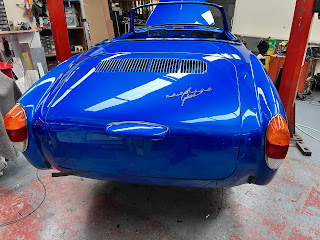Now for those of you that have assembled a Karmann Ghia's doors before, you will cringe as I start this rebuild as I did it all in the wrong order. But you only learn by trying!.
So the first job was to dig out the window mechanisms and clean off 53 years of dirt and grime. Then treat all unplated parts with rust killer and lubricate all the moving parts. It was then a case of offering the mechanism into the door and bolting it in place.
I then tried to offer the glass into the door and it will only go in one way and that is down through the slot in the top of the door. Well somehow I had managed to get the glass out of the door, when I stripped it, without removing the metal carrier on the bottom of the glass, but it was quite obvious now that there was no way that it would go back in like that. The slot was now too small to allow it to pass through. So I had to figure how to remove the carrier without breaking the glass. This was achieved with lots of WD40 and very gentle levering. I could then mount the carrier onto the mechanism and then lower the glass down through the slot and back into the carrier.
This takes immense patience, I even went to the trouble of making a special tool to try and insert them.
It didn't work! and it took me over three weeks and 21 rubbers before I managed to get only 5 rubbers into each door. If I had realised how difficult these were, I would have fitted them when I had the doors cut open and before it was sprayed . But you live and learn.
Now the other thing that I discovered when cleaning the windows was that the driver's door window was badly scratched due to being wound up and down without any rubbers in place and after finding that having the glass re-polished was more expensive than buying a new one, I bought a new one and had to strip the door again to fit it.
The final job was to fit the outer scraper strips. I had to wait weeks before the new fixing clips arrived and then managed to break three whilst trying to fit the strip incorrectly. I thought that the rubber sat on top of the door and pressed up against the metal strip between it and the glass. I eventually discovered that the rubber fits "over" the metal strip allowing the clips to snap in easily.
Now the good bit. It's time to fit the engine. This involved removing the carburettors and manifolds and the heater pipes and the front tray. It was more difficult to fit than expected as the new sports exhaust hit the underside of the bumper preventing it from seating correctly on the bell housing. I eventually modified the exhaust to give it some clearance and in it went. The carburettors went back on along with the heater pipes and rear tray and with the electrics and petrol connected it was time to see if it goes?
The final touch was to fit the steering wheel. This involved finding the old steering wheel and removing the associated parts that operate the indicators auto cancel and transfer them onto the new wheel. This involved drilling and tapping the new wheel to get the parts in the right place, but it worked and also extend the wire to the horn button. But it worked and the new steering wheel fit beautifully.
On the next blog I'll be fitting the door weather seals and fitting a couple of beautiful old badges that friends have given me.
Copyright 02.04.24 all rights reserved.
My Other Blogs:
1961 BSA A10 Super Rocket Motorcycle:
http://60sclassicmotorbikes.blogspot.com/2012/07/before.html
1961 Ariel Arrow Super Sport Motorcycle :
http://60sclassicmotorbikes.blogspot.com/2014/01/1961-aerial-golden-arrow-restoration.html
Miniature Land Rover Defender:
http://miniaturelandrover.blogspot.com/2016/02/1-miniature-land-rover-defender-idea.html?view=timeslide
Motorcycle Trailers / Caravans:
http://motorcycletrailersandcaravans.blogspot.com/2018/01/1-motorcycle-trailers-problem.html
























































